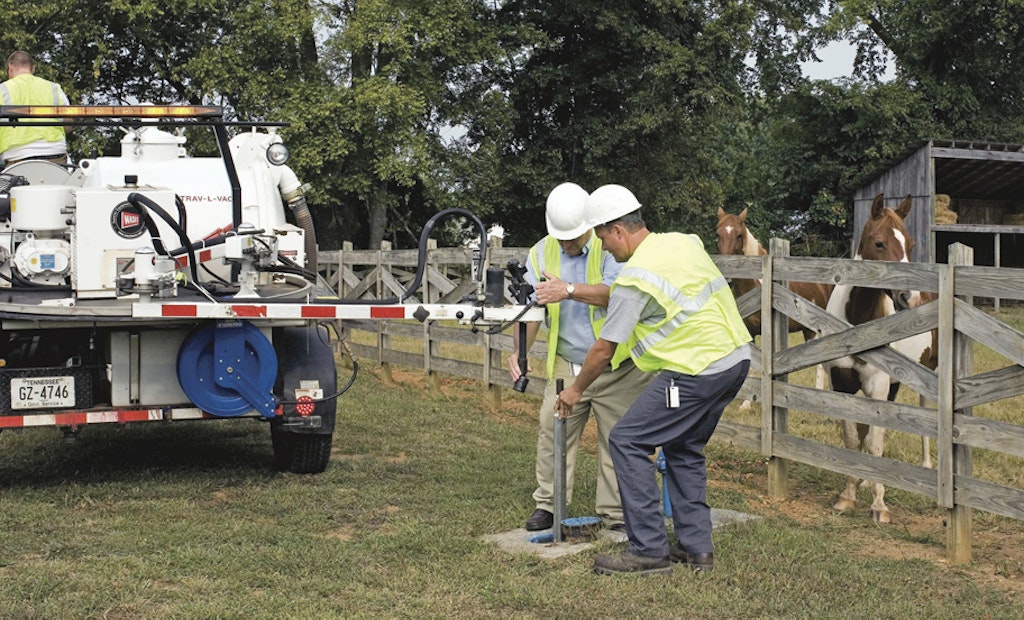Interested in Cleaning?
Get Cleaning articles, news and videos right in your inbox! Sign up now.
Cleaning + Get AlertsNo one likes being called in the middle of the night to the scene of a broken waterline. What’s even more frustrating is trying to locate the valve that controls the flow, only to discover it doesn’t work.
Nights like that are best forgotten and one reason why the Consolidated Utility District of Rutherford County, Tennessee, set out to establish a valve maintenance program. Now four years later, the crew at CUDRC sleeps better, knowing that if a problem does arise, it can instantly pinpoint the source and be confident that each one of its 18,000 valves will perform as intended, disrupting as few of its 130,000 customers as possible.
In its simplest form, a preventive maintenance program involves:
- Locating and mapping all valves in the system
- Recording pertinent information
- Cleaning out valve boxes or vaults
- Operating all valves to ensure they function properly.
But how do you accomplish this? “Whether you’re doing it in-house or with contract labor is probably going to make a pretty big difference in how you proceed,” says Jennifer Wood, engineering department manager for CUDRC, which decided to go in-house.
“Our general manager had run some numbers on how much it would cost per valve on a contract side versus per valve if we did it in-house. The cost came out relatively similar, but we were getting so much more work done per valve than if we contracted. So we found that to be a huge benefit. Also, the guys that are operating the valves, they know the system.”
Wood says the next step in organizing a maintenance program is deciding where to begin.
“Some people might only exercise a valve six inches or smaller or eight inches or smaller. Maybe they want to start in a certain part of the system or with what they consider a critical valve,” Wood says. “For us, we arranged it by a grid. We started in our water plant zone and worked outward. Some people might want to start with valves on their oldest line.”
A vital part of any program is data collection. CUDRC has been using the Vitals software program from E.H. Wachs and is looking to implement iWater GIS-linked software that will enable the utility to highlight problem areas and use data more efficiently in the office.
CUDRC completed the first round of its valve evaluation in April 2013 and is in the process of evaluating its system a second time. It also has added a second VMT-1 valve maintenance trailer with ERV-750 extended-reach valve exerciser from Wachs.
“With the two crews working full time we’ve gone through 21 percent of the system. So we’re able to be a little more efficient by having that second crew,” Wood says of the two-person teams. The utility also added a dump bed to one of its trucks, enabling crews to haul dirt should they need to reset a box. That has helped reduce the number of work orders that were previously passed along to the maintenance department.
Since initiating its valve program, CUDRC has stopped using the maintenance trailer to exercise 2-inch valves. “We found out more often than not we ended up breaking the stem,” Wood says. Crews now operate those by hand, along with butterfly valves, which can be a little more sensitive.
Wood says the first round of CUDRC’s exercise program uncovered critical issues in 30 percent of its system. “We’ve been able to cut that down the second time through by half,” she says.
CUDRC’s maintenance program also has significantly reduced the number of customer complaints. Now when leaks are detected crews know exactly where valves are located and that they are operable. “That’s a huge benefit for a utility to not have your customers out of water whenever you’re doing a repair,” Wood says.
Take a look at the full profile on Consolidated Utility District of Rutherford County in featured a few years ago in Municipal Sewer & Water.






